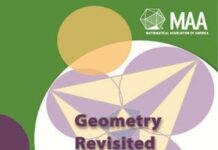
Ebook Info
- Published: 1991
- Number of pages: 496 pages
- Format: PDF
- File Size: 43.77 MB
- Authors: H. S. M. Coxeter
Description
This classic work is now available in an unabridged paperback edition. The Second Edition retains all the characterisitcs that made the first edition so popular: brilliant exposition, the flexibility permitted by relatively self-contained chapters, and broad coverage ranging from topics in the Euclidean plane, to affine geometry, projective geometry, differential geometry, and topology. The Second Edition incorporates improvements in the text and in some proofs, takes note of the solution of the 4-color map problem, and provides answers to most of the exercises.
User’s Reviews
Editorial Reviews: From the Publisher This classic work is now available in an unabridged paperback edition. The Second Edition retains all the characterisitcs that made the first edition so popular: brilliant exposition, the flexibility permitted by relatively self-contained chapters, and broad coverage ranging from topics in the Euclidean plane, to affine geometry, projective geometry, differential geometry, and topology. The Second Edition incorporates improvements in the text and in some proofs, takes note of the solution of the 4-color map problem, and provides answers to most of the exercises. About the Author Harold Scott MacDonald “Donald” Coxeter, FRS, FRSC, CC was a British-born Canadian geometer. Coxeter is regarded as one of the greatest geometers of the 20th century. He was born in London, received his BA and PhD from Cambridge, but lived in Canada from age 29.
Reviews from Amazon users which were colected at the time this book was published on the website:
⭐HSM Coxeter’s classic is everything everyone else says — funny, clear, elegant. The complexity level is high, but the prerequisites are minimal. The epigraphs constitute most of the humor — especially G.H. Hardy’s.Emphasizing beauty over power perhaps in math made more sense when Coxeter flourished, although the copyright disclaimer requires permission to use direct “machine code” copies, so much of this had relevance in the sciences then — the crystallography, the invariant spaces, the group theory, etc.The work is very taut and doesn’t rely on set theory too much. Coxeter places a dramatic perspective when talking about some of the conjectures that took some time to prove before included here, and the proof is oftentimes short and subtle.It’s one of those books that you wish you had more time for if geometry is not your niche.
⭐Euclid said “there is no royal road to learning geometry”. However geometry for the boomer generation has been easier to learn because of the classic H.S.M. Coxeter “Introduction to Geometry”. This 1980 final edition simply perfects the 1961 first edition that helped me start my career in computer graphics. The minor typographical errors have been fixed. One such defect in the first edition for equation 18.21 had stopped my progress in tensor notation for weeks before I could confidently mark it as a printing error. Almost all the exercise answers have been improved. And the four color map proof is mentioned. Returning to Coxeter now in 2014 I see it as a practical review for the serious physics enthusiast to get from the geometry of Euclid to that of the Einstein Field Equations. An alternate more modern and more difficult book covering this mathematics would be Penrose’s “Road to Reality” first published in 2004. Everyone must find their own road through geometry, this book might help you.
⭐H.S.M. Coxeter is a legend in Geometry, primarily for his work on higher dimensional objects…polytopes, and the Physics applicable, study of Symmetry. The book covers the gamut of Geometry, touching on the peaks and covering the entire range. No book could cover the entire subject, in one volume. This is an “Introduction” for someone who has already made peace with Mathematics….its not an elementary text. The proofs are rigorous and many details are not presented as the volume was written for university students. I reccomend it for true Math Philes. Dr.Pratt.
⭐A great book from a master! Highly recommended!
⭐This is one of those books that’s listed in the bibliography of almost every other geometry text I’ve read — and rightly so. Reading through it, you’ll find some absolute gems of geometric insight. So why am I giving it only three stars? Primarily because it misrepresents itself as an “Introduction,” which it isn’t. It’s much more like one of those fast-paced “ten countries in five days” package tours offerred by various travel agents. In a mere 412 pages, Coxeter zips through a vast number of topics — each of them actually a specialty area in the larger field of geometry. It simply isn’t possible for a book of this length to give the reader any kind of serious grounding in this material.In addition, some of the topics are ones at which Coxeter himself admitted he wasn’t very skilled. During his career, his main areas of interest were symmetry, n-dimensional Euclidean geometry, projective geometry, and higher-dimensional polygons. Things like topology and differential geometry were outside his territory, so the treatment of these topics in “Introduction” is not as engaging as his discussion of various isometries.This book originally grew out of a set of lectures that Coxeter gave to college-level math majors and math teachers. By all accounts, Coxeter was a very lively and engaging teacher; I imagine it must have been wonderful to listen to those lectures, and then have Coxeter’s own lecture notes (i.e., this book) as a reminder of everything that he said. Unfortunately, I don’t think the book stands as well on its own as a teacher; it needs Coxeter himself to fill in the gaps between the words and bring it to life.So if you already know this material, and you just want to discover some wonderful Coxeterian pearls of wisdom about the subject, then go for it; pay the hundred dollars. As your knowledge deepens, you’ll always be able to return to this book and find some new insight that you missed on a previous reading. There’s also a wonderful “visual” quality to the way Coxeter thinks about geometry — something that’s missing from many other texts.On the other hand, if your goal is to learn the material covered in this book, you’ll need other books to do it. This is definitely not a good choice for a first exposure to the subject.
⭐A better title for this book would be “Advanced Topics in Geometry”. The chapters are pretty much self-contained.This book presumes a thorough, rigorous knowledge of high school geometry such as you might get in a college geometry course designed for future teachers along with considerable mathematical maturity.
⭐The only reason I give it a 4/5 is because the diagrams need to be labeled. It’s pretty hard to keep up with the conversation when the author refers to a poorly labeled complex diagram. I think Coxeter’s other book does a great job and you can download it for free or buy it for under $10. It is a great introduction to college level geometry; and introduction because it doesn’t really go into too much depth, but is not shallow either. I would recommend it, but buy it used because it’s just not one of those books you’ll constantly look back at for help in the future…it’s pretty much a one read and that’s it.
⭐Excellent Text!
⭐The content itself is good enough, but I didn’t like the color of the cover and the fact that it is paper back. Paying tribute to such a book should be by putting it in a more expensive format.
Keywords
Free Download Introduction to Geometry 2nd Edition in PDF format
Introduction to Geometry 2nd Edition PDF Free Download
Download Introduction to Geometry 2nd Edition 1991 PDF Free
Introduction to Geometry 2nd Edition 1991 PDF Free Download
Download Introduction to Geometry 2nd Edition PDF
Free Download Ebook Introduction to Geometry 2nd Edition




